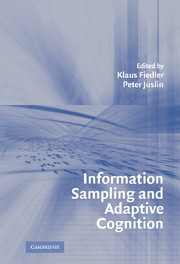Book contents
- Frontmatter
- Contents
- List of Contributors
- PART I INTRODUCTION
- PART II THE PSYCHOLOGICAL LAW OF LARGE NUMBERS
- PART III BIASED AND UNBIASED JUDGMENTS FROM BIASED SAMPLES
- PART IV WHAT INFORMATION CONTENTS ARE SAMPLED?
- 11 What's in a Sample? A Manual for Building Cognitive Theories
- 12 Assessing Evidential Support in Uncertain Environments
- 13 Information Sampling in Group Decision Making: Sampling Biases and Their Consequences
- 14 Confidence in Aggregation of Opinions from Multiple Sources
- 15 Self as Sample
- PART V VICISSITUDES OF SAMPLING IN THE RESEARCHER'S MIND AND METHOD
- Index
- References
11 - What's in a Sample? A Manual for Building Cognitive Theories
Published online by Cambridge University Press: 02 February 2010
- Frontmatter
- Contents
- List of Contributors
- PART I INTRODUCTION
- PART II THE PSYCHOLOGICAL LAW OF LARGE NUMBERS
- PART III BIASED AND UNBIASED JUDGMENTS FROM BIASED SAMPLES
- PART IV WHAT INFORMATION CONTENTS ARE SAMPLED?
- 11 What's in a Sample? A Manual for Building Cognitive Theories
- 12 Assessing Evidential Support in Uncertain Environments
- 13 Information Sampling in Group Decision Making: Sampling Biases and Their Consequences
- 14 Confidence in Aggregation of Opinions from Multiple Sources
- 15 Self as Sample
- PART V VICISSITUDES OF SAMPLING IN THE RESEARCHER'S MIND AND METHOD
- Index
- References
Summary
PREVIEW
How do you build a model of mind? I discuss this question from the point of view of sampling. The idea that the mind samples information – from memory or from the environment – became prominent only after researchers began to emphasize sampling methods. This chapter provides a toolbox of potential uses of sampling, each of which can form a building block in a cognitive theory. In it I ask four questions: who samples, why, what, and how.
Who: In the social sciences (in contrast to the natural sciences), not only researchers sample, but so do the minds they study. Why: I distinguish two goals of sampling, hypotheses testing and measurement. What: Researchers can sample participants, objects, and variables to get information about psychological hypotheses, and minds may sample objects and variables to get information about their world. How: I distinguish four ways to sample: (i) no sampling, (ii) convenience sampling, (iii) random sampling from a defined population, and (iv) sequential sampling. These uses of sampling have received unequal attention. The prime source of our thinking about sampling seems to be R. A. Fisher's small-sample statistics, as opposed to the use of random sampling in quality control, the use of sequential sampling, and the use of sampling for measurement and parameter estimation. I use this legacy to identify potentials of sampling in adaptive cognition that have received little attention.
In his Opticks, Isaac Newton (1952/1704) reported experiments with prisms to demonstrate that white light consists of spectral colors.
- Type
- Chapter
- Information
- Information Sampling and Adaptive Cognition , pp. 239 - 260Publisher: Cambridge University PressPrint publication year: 2005

